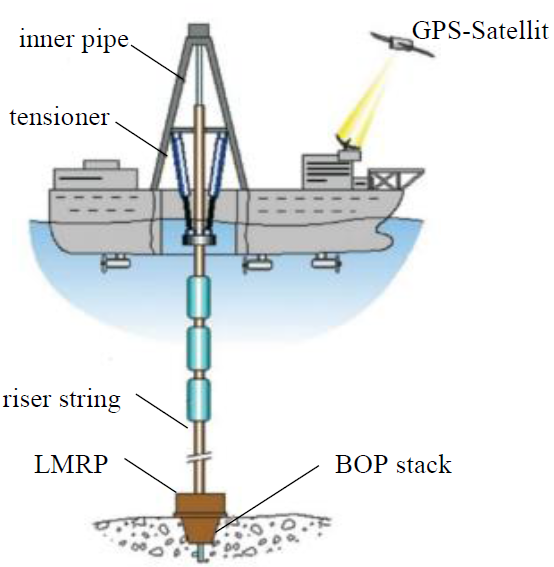Nonlinear Dynamic Analysis of Direct Acting Tensioner of an Offshore Floating Platform
DOI:
https://doi.org/10.46604/aiti.2020.4529Keywords:
direct acting tensioner, nonlinear dynamic model, accumulatorAbstract
The offshore floating platform is the key equipment in offshore and gas development. The significant heave motions occur with the excitation of wind and waves, which will affect the safety of a riser system. A direct acting tensioner can be applied to reduce the effects on the riser system and be widely used on different kinds of offshore platforms. Based on the analysis of the structure and working principle of a direct acting tensioner (DAT), the nonlinear dynamic performance of DAT riser system was studied. Additionally, the dynamic model of the DAT riser system is established and the dynamic response was gained by the numerical integration method. The differences of dynamic responses were compared between a linear model and a nonlinear model. The response on different side of the equilibrium position is asymmetric because of the nonlinear stiffness of DAT. The results can be helpful for the design of DAT.
References
T. Wang and Y. Liu, “Dynamic response of platform-riser coupling system with hydro-pneumatic tensioner,” Ocean Engineering, vol. 166, pp. 172-181, October 2018.
B. Chen, J. Yu, Y. Yu, L. Xu, H. Wu, and Z. Li, “Modeling approach of hydro-pneumatic tensioner for top tensioned riser,” Journal of Offshore Mechanics and Arctic Engineering, vol. 140, no. 5, October 2018.
R. G. Pestana, F. E. Roveri, R. Franciss, and, G. B. Ellwanger, “Marine riser emergency disconnection analysis using scalar elements for tensioner modeling,” Applied Ocean Research, vol. 59, pp. 83-92, September 2016.
J. K. Woodacre, R. J. Bauer, and R. A. Irani, “A review of vertical motion heave compensation systems,” Ocean Engineering, vol. 104, pp. 140-154, August 2015.
Y. Wu, “A new operability and predictability enhanced riser control system for deepwater marine operation: an integrated riser hybrid tensioning system,” Ph.D. dissertation, Dept. Elect. Eng., The University of Texas at Austin, 2015.
Z. Q. Xu, W. Y. Tang, H. X. Xue, and Z. Q. Hu, “Safety assessment of a top-tensioned TLP production riser in disastrous marine environment,” China Ocean Engineering, vol. 28, no. 3, pp. 44-49, 2010.
Y. Peng and B. Zhao, “Analysis of factors influencing the crane heave compensation system compensation effect at deepwater drilling rig,” Journal of Residuals Science & Technology, vol. 13, no. 8, 2016.
S. Liu and L. Li, “Control performance simulation on heave compensation system of deep-sea mining based on dynamic vibration absorber,” International Conference on Digital Manufacturing & Automation, December 2010, pp.441-445.
J. T. Hatleskog and M. W. Dunnigan, “Heave compensation simulation for non-contact operations in deep water,” Oceans, September 2006, pp. 1-6.
Y. T. Zhang, Z. D. Liu, H. Jiang, G. B. Wu, and Z. L. Zhang, “Study on active force of compensation system for floating drilling platform,” Oil Field Equipment, vol. 39, no.4, pp. 1-4, April 2010.
H. Lee, M. I. Roh, S. H. Ham, and S. Ha, “Dynamic simulation of the wireline riser tensioner system for a mobile offshore drilling unit based on multibody system dynamics,” Ocean Engineering, vol. 106, pp. 485-495, September 2015.
S. H. Ham, M. I. Roh, and J. W. Hong, “Dynamic effect of a flexible riser in a fully connected semisubmersible drilling rig using the absolute nodal coordinate formulation,” Journal of Offshore Mechanics and Arctic Engineering, vol.139, no. 5, October 2017.
W. Shisheng, X. Bin, and L. Xinzhong, “The motion response analysis of deep water typical TLP in environment conditions of south china sea,” Shipbuilding of China, vol. 52, no. 1, pp. 94-101, 2011.

Published
How to Cite
Issue
Section
License
Submission of a manuscript implies: that the work described has not been published before that it is not under consideration for publication elsewhere; that if and when the manuscript is accepted for publication. Authors can retain copyright in their articles with no restrictions. is accepted for publication. Authors can retain copyright of their article with no restrictions.
Since Jan. 01, 2019, AITI will publish new articles with Creative Commons Attribution Non-Commercial License, under The Creative Commons Attribution Non-Commercial 4.0 International (CC BY-NC 4.0) License.
The Creative Commons Attribution Non-Commercial (CC-BY-NC) License permits use, distribution and reproduction in any medium, provided the original work is properly cited and is not used for commercial purposes.







